|
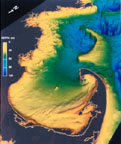
|
Stellwagen Bank sits like a
wall at the edge of Massachusetts Bay, forcing
water from the Gulf of Maine and waters inside the
Bay around its edges and over its surface. The
sanctuary's seafloor is consists of a variety of
habitat types found across the Gulf of Maine.
(Computer image by USGS)
|
|
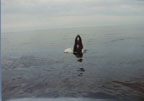
|
At times the surface of the
sea can be like glass, smooth and uninterrupted by
breaking waves. Here, a humpback whale
(Megaptera noveangliae) click image for
more...(photo: AnneSmrcina)
|
|

|
Atlantic herring (Clupea
harengus) is one of the marine fish species not
considered overexploited. Large schools of these
small fish are click image for more...
(photo: Jon Witman)
|
|
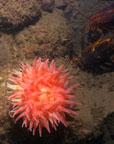
|
A northern red anemone
(Urticina felina) sits atop a boulder as an
American lobster (Homarus americanus) pears
out from below. Deep boulder reefs provide shelter
for a large number of species. (photo: Dann
Blackwood and Page Valentine, USGS)
|
|
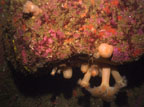
|
Frilled anemones
(Metridium senile) share a boulder with
numerous other encrusting animals. The deep boulder
reefs of northern waters can be just as click
image for more... (photo: Dann Blackwood and
Page Valentine, USGS)
|
|

|
These sponges (Polymastia
sp.) sit in a constant current that brings a
ready supply of food. The rock and click image
for more.... (photo: Dann Blackwood and Page
Valentine, USGS)
|
|
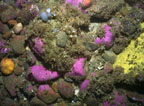
|
Encrusting sponges and
coralline algae coat parts of this cobble field.
Other animals seek shelter in the nooks and
crannies. (photo: Dann Blackwood and Page
Valentine, USGS)
|
|
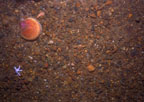
|
A sea scallop (Placopecten
magellanicus) sits alone in a gravel field.
Rock and gravel substrates are click image for
more.... (photo: Dann Blackwood and Page
Valentine, USGS)
|
|
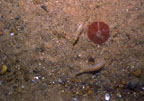
|
As can be deduced from their
names, the sand lance (Ammodytes americanus)
and sand dollar click image for more...
(photo: Dann Blackwood and Page Valentine,
USGS)
|

|
A field of live sand dollars
(Echinarachnius parma) sits on a sandy plain
along with one test (the white inner structural
form from a dead sand dollar). (photo: Dann
Blackwood and Page Valentine, USGS)
|
|
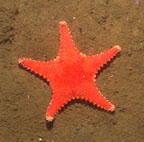
|
A brightly colored horse star
(Hippasteria phrygiana) sits on silty sand.
Colorful sea stars are found all over the globe,
including the Gulf of Maine. (photo: Dann Blackwood
and Page Valentine, USGS)
|
|

|
A sponge forest (Isodyctia
sp.) on a sandy stretch of the bank provides
shelter for a longhorn sculpin. click image for
more... (photo: Peter Auster and Paul
Donaldson, NURC, UConn)
|
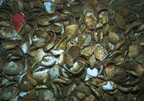
|
Shell piles collect in
troughs between sand waves on the top of Stellwagen
Bank. Some animals find shelter between the shells.
(photo: Dann Blackwood and Page Valentine,
USGS)
|
|
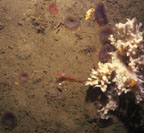
|
Fan worms (Myxicola
infundibulum) build mucus tubes into the mud
and then spread their gills to catch floating
plankton and detritus, while a Pandallid shrimp
comes out from hiding under a sponge (Iophon
sp.). (photo: Dann Blackwood and Page
Valentine, USGS)
|
|
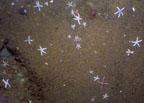
|
A collection of sea stars
(Asterias vulgaris) gives a "starry night"
effect to this muddy basin area in the sanctuary.
(photo: Dann Blackwood and Page Valentine,
USGS)
|
|

|
Cerianthids (Cerianthus
borealis) dig their columns into the mud.
Looking somewhat like palm trees, these click
image for more... (photo: Peter Auster and Paul
Donaldson, NURC, UConn)
|
|

|
These holes in the mud of
Stellwagen Basin may be the homes of American
lobsters (Homarus americanus) or click
image for more... (photo: Peter Auster and Paul
Donaldson, NURC, UConn)
|
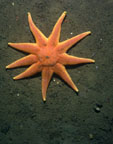
|
A smooth sun star sits on the
muddy sea floor, looking much like a child's
drawing of the sun in the sky. (photo: Dann
Blackwood and Page Valentine, USGS)
|